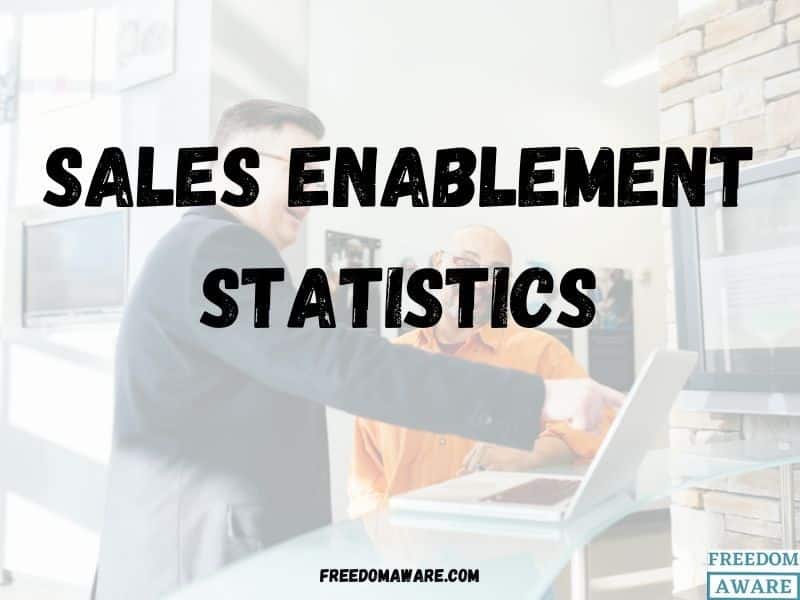
Below, are some sales enablement statistics you should know;
In today’s fast-paced sales landscape, staying ahead of the competition requires more than a solid sales strategy – it demands a data-driven approach. Sales enablement has emerged as a crucial component of modern sales organizations, empowering teams to sell more effectively and efficiently. But what does the data say about the impact of sales enablement on business outcomes?
In this article, we’ll delve into the latest sales enablement statistics, uncovering key trends, benchmarks, and insights that will help you optimize your sales enablement strategy and drive revenue growth.
Key Sales Enablement Statistics (Editor’s Pick)
- Organizations leveraging sales enablement technology are twice as likely to harness analytics to optimize sales strategies.
- 23% of companies with a formal Revenue Enablement program support Customer Success, 18% support presales, and 15% support marketers, among other functions. Additionally, 25% have enablement reporting to the Chief Revenue Officer (CRO).
- 70% of consumers prefer personalized experiences using their data.
- 81% of organizations see sales enablement as a revenue team efficiency booster.
- The global sales enablement platform market is projected to grow from $3.41 billion in 2023 to $12.7 billion by 2030.
- 92% of executives credit sales enablement investments for boosting sales, and 84% plan continued or increased spending in this area.
- 90% of organizations now have a dedicated sales enablement team, reflecting a 20% annual growth and increased industry recognition.
General Sales Enablement Statistics
- The sales enablement technology market is predicted to reach more than $3 billion by 2026. (Source)
- The global sales enablement platform market, valued at $3.41 billion in 2023, is poised for rapid growth, reaching $12.7 billion by 2030 at a 19.70% CAGR. (Source)
- A personalized shopping journey significantly influences customer loyalty, with 60% of consumers expressing intent to make repeat purchases. (Source)
- While critical for optimization, analytics visibility into effective sales enablement practices is limited to just 43% of organizations, leaving a substantial gap in data-driven decision-making. (Source)
- The industry is predicted to grow to $11 billion by 2032. (Source)
- A vast majority (over 90%) of companies have implemented some form of enablement program. (Source)
- Despite the growing emphasis on customer retention amid economic challenges, a surprising 79% of B2B companies overlook equipping their teams for customer success. (Source)
- Only 10% of sales enablement content drives a surprising 50% of all prospect interaction. (Source)
- A significant portion of B2B companies (65%) have adopted value-based selling (VBS). To quantify the value proposition, 33% of these businesses utilize ROI calculators when interacting with economic buyers and influencers. (Source)
- Customer experience is paramount in today’s market. A significant 80% of customers equate its importance to product or service quality. (Source)
- Staff compensation and benefits represent the largest allocation within sales enablement budgets. This trend is projected to persist, with nearly half of sales enablement leaders anticipating increased budget and staffing in the coming year. (Source)
- Staff compensation and benefits represent the largest allocation within sales enablement budgets. This trend is projected to persist, with nearly half of sales enablement leaders anticipating increased budget and staffing in the coming year. (Source)
- A strong majority (63%) of individuals expressed a higher propensity to share personal data when they perceive substantial value in return. Fostering trust is equally crucial in this exchange. (Source)
- A positive experience can drive over a third (36%) of consumers back to a brand, regardless of price or convenience. (Source)
- 70% of consumers accept personalization if brands use their data. (Source)
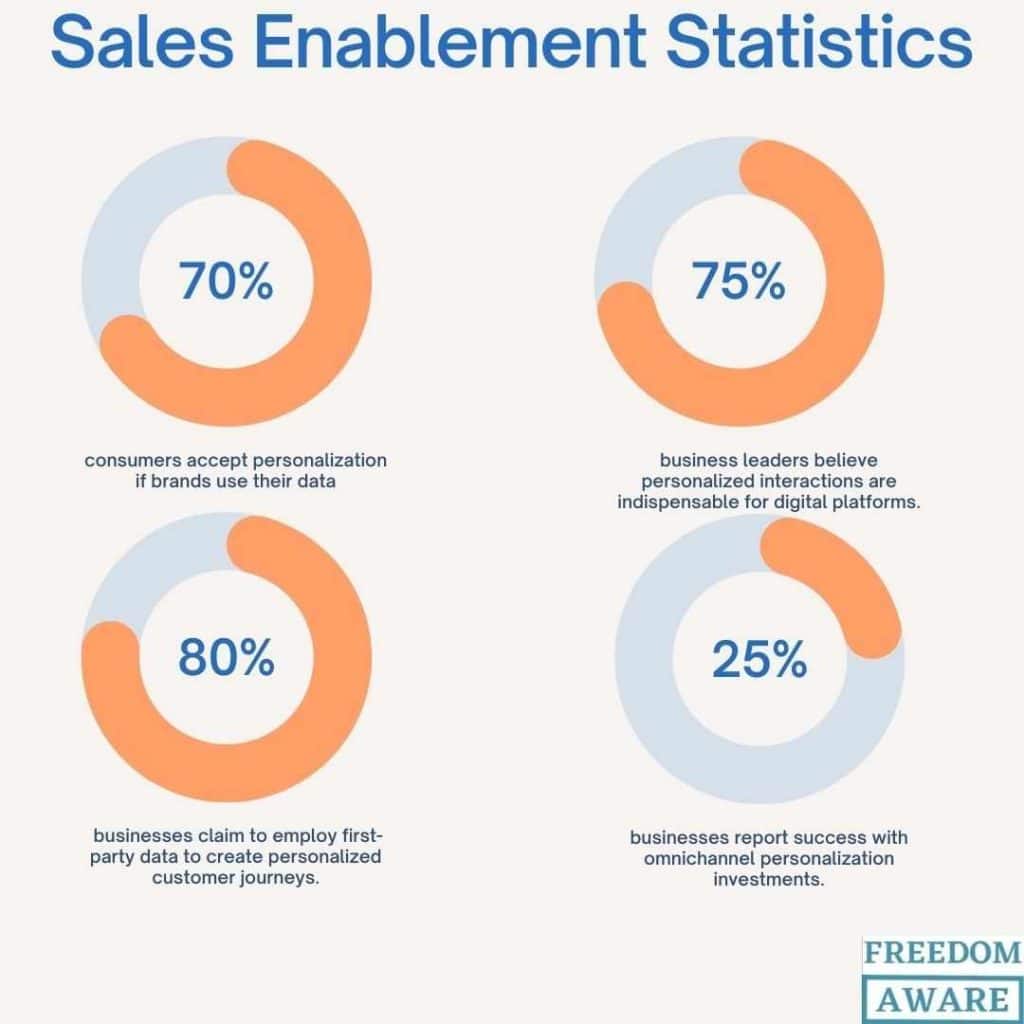
- A resounding 75% of business leaders believe personalized interactions are indispensable for digital platforms. (Source)
- A vast majority (80%) of businesses claim to employ first-party data to create personalized customer journeys. (Source)
- Only 25% of businesses report success with omnichannel personalization investments. (Source)
- With an average of 9.2 sales interactions per deal, sales teams must be well-versed in market, product, customer, and competitor landscapes. (Source)
- Overwhelmingly, 75% of buyers express a preference for virtual interactions with salespeople and the autonomy to explore products independently. (Source)
- Sales enablement is predominantly managed by the sales team (38%), with marketing providing additional support. Nevertheless, there is clear evidence of growing cooperation between sales and marketing, as demonstrated by the 77% of respondents reporting collaborative efforts. (Source)
- People & Teams represents the most significant opportunity for growth, with an average rating of 3.26 placing organizations between Standard and Advanced maturity levels. Only 10% of respondents achieved an Advanced rating in this area. (Source)
- Over 90% of sales representatives surveyed reported a dramatic shift in buyer behavior within the past year and a half. (Source)
- According to 88% of U.S. consumers, the amount of personal information they divulge is contingent upon their trust in a company. (Source)
- Sales enablement generally affects 2.5 stages of the buyer’s journey, excelling in the early stages. Though less prominent in customer advocacy or post-loss contexts, its significance in post-sale and service aspects is undeniable. (Source)
- Sales enablement is predominantly overseen by the Chief Sales Officer (CSO) in 35% of companies. A further 25% of organizations assign this role to Chief Revenue Officers (CROs) or Chief Growth Officers (CGOs), indicating a trend towards increased collaboration between sales and marketing. (Source)
- Consumers are split on whether brands act in their best interest: 37% trust businesses to keep their data secure and use it responsibly, while another 37% do not trust online retailers with their data. (Source)
- 23% of companies with a formal Revenue Enablement program support Customer Success, 18% support presales, and 15% support marketers, among other functions. Additionally, 25% have enablement reporting to the Chief Revenue Officer. (Source)
- A surprising 79% of B2B companies overlook customer success enablement, despite the growing emphasis on customer retention amidst economic challenges. (Source)
- Currently, 35% of sales enablement teams also fulfill marketing responsibilities, but this dynamic is likely to evolve. A majority of CSOs anticipate sales enablement supporting marketing within the next three years, while nearly half foresee its expansion into customer success. (Source)
- A clear majority (62%) of sales training is dedicated to personal selling skills like closing deals and negotiation, eclipsing the focus on customer understanding, ICPs, and personas (54%). This data implies a sales culture prioritizing interactions over product expertise, as evidenced by only 33% emphasizing product knowledge. (Source)
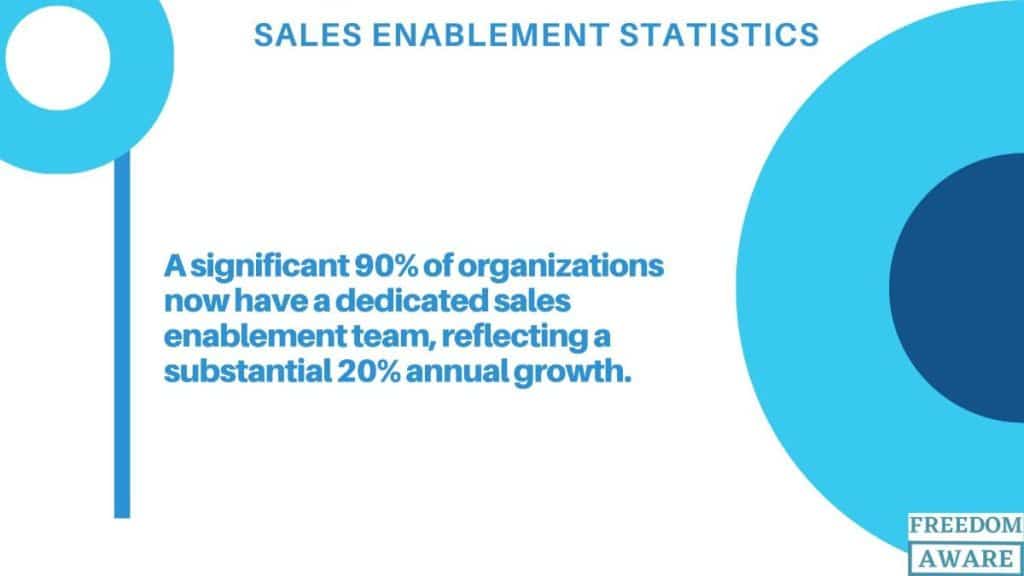
- A significant 90% of organizations now have a dedicated sales enablement team, reflecting a substantial 20% annual growth. This trend underscores the increasing recognition of the critical role of sales enablement. (Source)
- More than half of respondents (54%) intend to invest in AI-powered meeting scheduling tools to help salespeople optimize their time and pinpoint optimal meeting times. (Source)
- A substantial 65% of survey participants agree that the evolving buyer landscape necessitates fresh sales methodologies. To thrive in this environment, businesses must engage customers on multiple platforms as buyers curate their journeys. (Source)
- While direct/field (63%) and inside sales reps (59%) continue to be the primary beneficiaries of sales enablement, the function is expanding to support a broader range of roles. Notably, post-sales functions like account management (54%) and services/customer success (18%) are receiving increased attention. (Source)
Sales Enablement Statistics on Performance
- Survey results confirm the powerful impact of sales enablement on business outcomes, with 68% of respondents highlighting the necessity of evolving sales enablement strategies. (Source)
- Companies equipped with sales enablement programs significantly outperform their counterparts, boasting a 49% win rate on forecasted deals compared to the 42.5% win rate of those without such programs. (Source)
- Sales enablement efforts primarily focus on boosting sales productivity (28%), ensuring consistent rep performance (23%), and optimizing overall revenue (18%). (Source)
- A majority of companies (62%) rate sales enablement as highly effective in cross-functional corporate initiatives. Furthermore, sales enablement excels at aligning initiatives with sales goals, with a strong above-average rating of 59%. (Source)
- Tenure is a critical factor in sales enablement effectiveness. Teams with a track record of over two years in sales enablement outperform their counterparts by a significant five percentage points in terms of win rate. (Source)
- A majority of companies, representing 87% across all scales, are committed to preserving or growing their sales enablement budgets in the next year. (Source)
- Sales enablement platforms deliver a significant boost to win rates, with users outperforming their counterparts by a substantial seven percentage points. (Source)
- A vast majority of executives (92%) affirm that sales enablement investments have positively impacted sales performance this past year. This confidence is reflected in the 84% of executives planning to sustain or expand these investments in the upcoming year. (Source)
- Companies that plan to sustain or grow their sales enablement budgets enjoy a four percentage point higher win rate compared to those considering budget reductions. This data underscores the strategic importance of sales enablement, particularly in challenging economic climates. (Source)
- Sales enablement is crucial as it prepares salespeople to use tools and resources for virtual engagement effectively. Research has shown that sales enablement functions that manage sales technology achieve win rates six percentage points higher than those that do not. (Source)
- Sales enablement is a key driver of efficiency for revenue teams, with 81% of organizations recognizing its positive impact on streamlining sales processes. (Source)
- Leading-edge companies are expanding their focus from traditional sales enablement to a comprehensive revenue enablement strategy. (Source)
- Sales reps dedicate less than half (35.2%) of their time to active selling. (Source)
Sales Enablement Technology Benchmarks (Sales Enablement Statistics)
- Enablement technology frees up nearly two extra workdays per week for sales reps to focus on customers, by automating content management and search, boosting productivity by 80%. (Source)
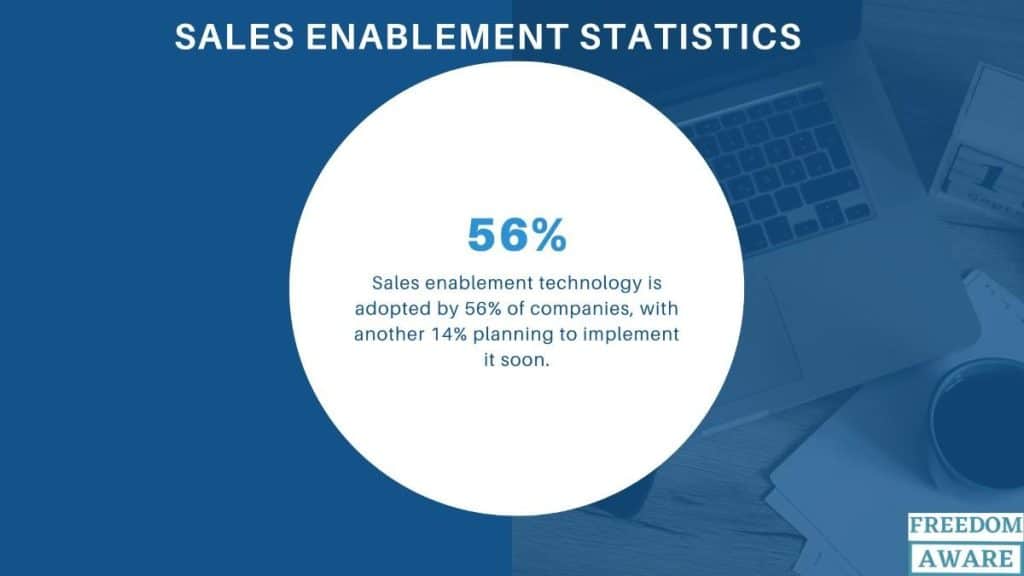
- Sales enablement technology is adopted by 56% of companies, with another 14% planning to implement it soon. (Source)
- While 58% of companies have a sales enablement function, only 19% leverage technology, hindering their ability to scale training and coaching for larger sales teams. (Source)
- MindTickle’s sales readiness platform accelerates sales rep onboarding by 60% through remote development and coaching, boosting overall performance. (Source)
- Less than half of executives grasp the potential of robotics and AI in enhancing customer experience, despite growing consumer expectations for seamless, personalized interactions. (Source)
- Digital sales rooms and other sales engagement tools correlate with a 46% higher win rate over the past year. (Source)
- Companies without sales enablement tools struggle with client retention, with 36% facing challenges in this area. (Source)
- Enablement technology empowers sales reps with quick access to information, boosting confidence and knowledge. Ninety-seven percent of users report improved client interactions, while 68% appreciate reduced uncertainty. (Source)
- Sales enablement technology doubles the likelihood of gaining insights into effective sales practices through analytics, driving data-driven improvements. (Source)
- Sales teams juggle an average of six different tools, highlighting the complexity of modern sales technology stacks. (Source)
- C-suite leaders prioritize sales enablement tools as the top tech investment for boosting sales productivity, with 55% supporting this view. (Source)
- Sales enablement technology adoption is on the rise, with a 5% increase to 65% of organizations using these tools this year. (Source)
- To streamline operations, 43% of companies plan to consolidate their technology stacks within the next 18 months. (Source)
- The MarTech market is booming, expanding from $413.6 billion in 2023 to a projected $2.1 trillion by 2032, with a rapid growth rate of 19.4% annually. (Source)
- As technology advances, customer expectations for personalized experiences are rising, with 73% demanding greater customization. (Source)
- AI-powered chatbots are a popular choice for enhancing customer experience, with 47% of respondents favoring them for quick query resolution. (Source)
Sales Enablement Hurdles (Sales Enablement Statistics)
- Insufficient data, poor training, and talent mismatches contribute to nearly half of sales reps missing quotas. (Source)
- Privacy concerns hinder personalized experiences, with 43% of U.S. consumers resisting data collection. (Source)
- Lack of staff and resources is also seen as one of the biggest barriers to sales enablement maturity as cited by 52% of salesforce. (Source )
- Many sales enablement teams struggle to demonstrate value due to limited data analysis and ineffective communication of impact. (Source)
- Sales reps face a trifecta of challenges: intense competition, economic headwinds, and customer retention pressures. (Source)
- Sales enablement significantly impacts sales cycle time, quota attainment, and win rates, yet 42% of companies lack such programs. (Source)
- Transparency in data usage builds trust, with 71% of customers more likely to share personal information with companies that clearly explain its purpose. (Source)
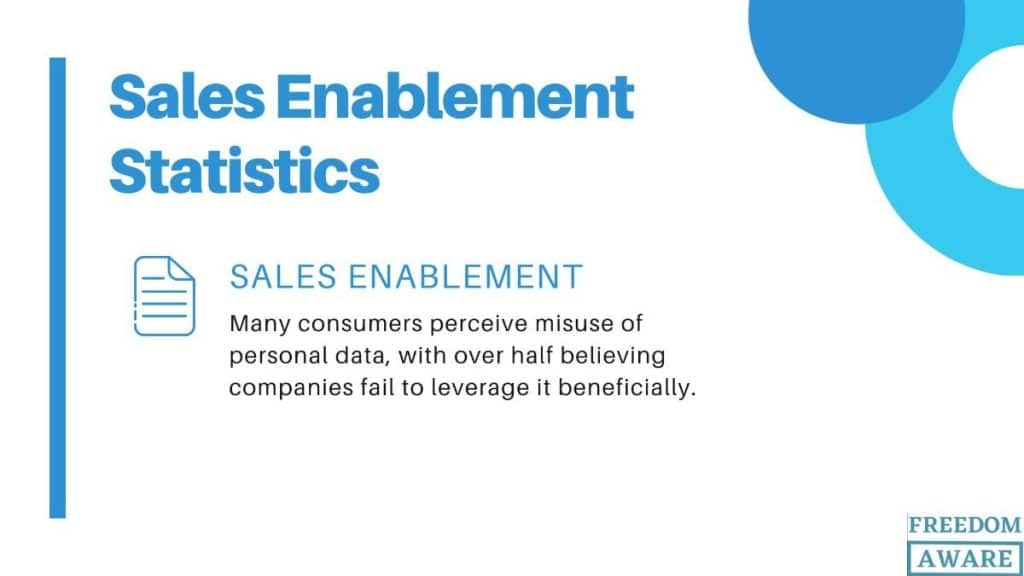
- Many consumers perceive misuse of personal data, with over half believing companies fail to leverage it beneficially. (Source)
- Access to accurate, unified customer data is a major hurdle for personalization, with many organizations struggling to provide a single source of truth. (Source)
- Concerns over AI ethics are prevalent, with customers demanding human oversight in AI decision-making. (Source)
- Trust is paramount in the age of AI, with customers expecting companies to maintain ethical standards. (Source)
- A shortage of skilled sales enablement professionals with expertise in technology, data, content, and operations is hindering industry progress. (Source)
- Inconsistent customer experiences across departments frustrate consumers, with frequent information repetition being a common pain point. (Source)
- Access to content is a major challenge for sales reps without enablement technology, impacting productivity and knowledge sharing. (Source)
- Increasing revenue, effective coaching, and accelerating sales cycles are top priorities for organizations. (Source)
- Poor onboarding disrupts operations, leading to lost opportunities and hindered growth, according to 88% of respondents. (Source
- A significant gap exists between customer needs and employee understanding, with less than half of consumers feeling understood by sales reps. (Source)
- Limited staffing and resources are major obstacles to achieving sales enablement maturity. (Source)
- While budgets exist, companies often struggle to implement sales technology due to cultural barriers and skill deficiencies. (Source)
- Consumers are increasingly protective of their personal information. (Source)
- Customers desire personalized experiences but often encounter impersonal interactions, highlighting a gap in customer-centric strategies. (Source)
Sales Enablement Earnings (Sales Enablement Statistics)
- Sales enablement specialists earn an average base salary of $84,365, with total compensation reaching $106,973. (Source)
- Sales enablement certifications boost earnings by $9,733 annually, while non-managerial roles earn $17,275 less than the average. (Source)
- Sales enablement managers earn an average base salary of $105,330, with total compensation reaching $146,791. (Source)
- A majority (61.3%) believe sales enablement salaries undervalue the role’s business impact. (Source)
- Additional earnings for sales enablement roles average $38,877 through bonuses and incentives. (Source)
- U.S. sales enablement professionals earn an average of $119,689 annually, with a range from $90,000 to $179,144. (Source)
- Over two-thirds of respondents receive bonuses or commissions. (Source)
- The average annual sales enablement salary is $100,390, with total compensation reaching $139,267. (Source)
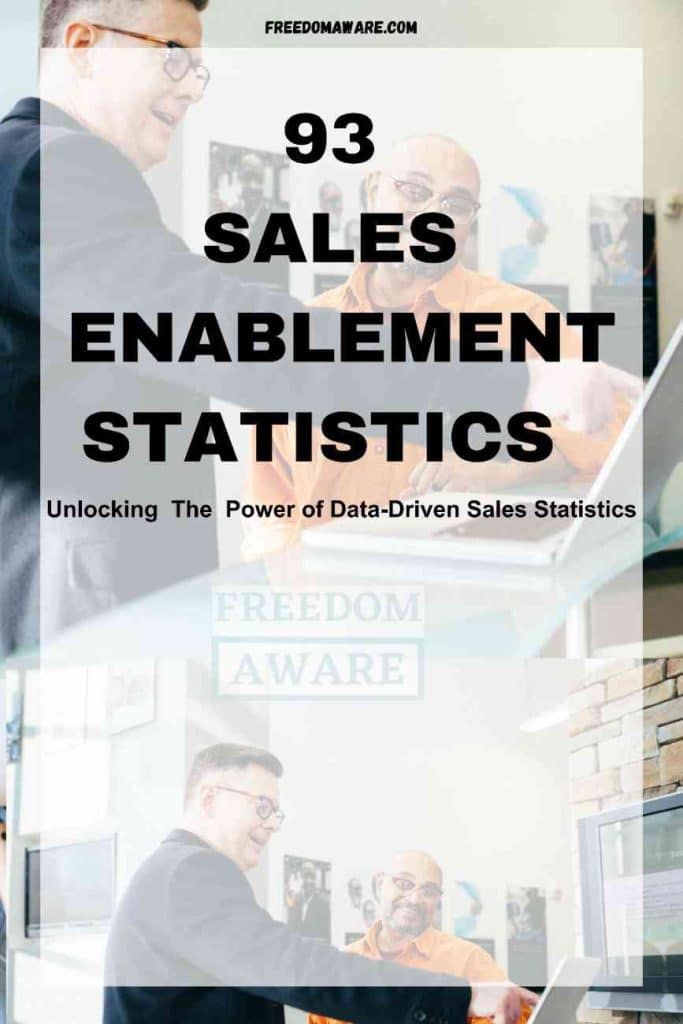
Conclusion (Sales Enablement Statistics)
Sales enablement is a critical component of a successful go-to-market strategy. With 87% of top cloud companies investing in this function, it’s evident that sales enablement is a key differentiator. By optimizing sales processes and equipping reps with the necessary resources, businesses can achieve substantial gains in revenue and win rates.

Leave a Reply